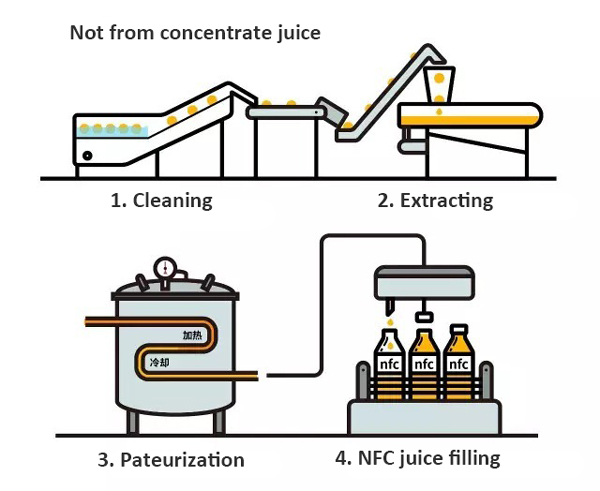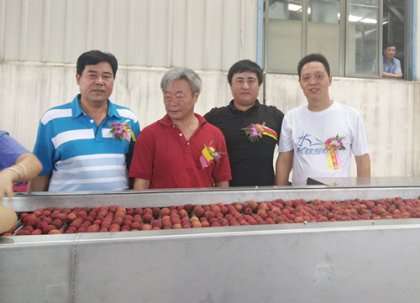NFC juice production and consumption
What is NFC juice?
With the improvement of living standard, customers pay more attention to the health and nature. Healthy and low-calorie drinks become more popular.
NFC juice rises in response to the market trend. NFC is the short version of Not From Concentrate. It is produced by fruit juice extraction, sterilization and filling, without the concentration or reduction process. So NFC juice preserves more nutrition and flavors than traditional drinks. Also, the technology and price are higher.

NFC juice production process
-
NFC juice usually adopts original juice or frozen original juice as raw materials.
-
Original juice are extracted from fresh fruits. The fruits need cleaning and sorting before extracting.
-
If it is made of frozen fruit juice, the first step is to unfreeze.
-
To make blended fruit juice, you need to mix different fruit juice in proportion.
-
Sterilization has ultra-high pressure processing and pasteurization method. The former one is carried out in normal temperature, so it has less damage to the juice flavor and nutrition.
-
Filling process also has cold-filling and hot-filling 2 methods. Cold filling requires to lower the temperature of sterilized juice to 20℃. Cold-filling fruit juice has shorter shelf life and need to be preserved in cold storage.
Based on different production technology, NFC juice can be classified into room temperature NFC juice and Cold-storage NFC juice. The latter is more popular. It has higher nutritive value and better taste, but it also has higher requirement on the cold chain, and shorter shelf life.
The shelf life of NFC juice is influenced by the raw materials quality, processing technology, and packaging. Usually, it is shorter than 1 month in 0-4℃ condition.

NFC juice and FC juice
The opposite of NFC juice is FC juice, which means From Concentrate. It is made by adding water, sugar, and preservatives to the concentrated juice. FC juice has long shelf life and low cost, so it become the most common fruit juice drinks in the market. But with the concentration and reduction processes, FC juice has great nutrition and flavor loss.
How to identify NFC juice?
NFC juice is labeled the storage mode and storage duration.
The ingredient list of NFC juice includes only fresh juice or fresh juice and fruit pulp, while the ingredients of FC juice are concentrated juice, water, preservatives, pigment, and other additives.

NFC juice consumption in America
NFC juice emerges in the 1990s in America and Europe. In the past 30 years, NFC juice consumption keep growing in America. In 2015, the market share of NFC juice was 30%, which has become a popular drink. Even in the time when the total fruit juice consumption drops by 1%, the consumption of NFC juice also grows by 4%.
Nowadays, Americans consume 1.4 million gallons of concentrated orange juice every month. In contrary, the consumption of fresh fruit juice is 19.1 million tons, about 13 times of the former. NFC juice takes up 60% of the total 100% juice consumption.
Challenges of NFC juice industry
Higher technical difficulty
FC juice manufactures can purchase concentrated juice from distant places, while NFC juice production need stable local fresh fruit supply. Besides, every fruit need different processing technology and equipment. Many low temperature cold press production line for NFC juice production are imported overseas. So it is common that many manufacturers share one juice production line.
Higher transportation and storage cost
NFC juice need cold chain and cold storage. It can only last about 1 month in 0-4℃. The strict transportation condition and short storage time push up the cost and price.
High-end fruit juice market is underdeveloped
The distribution channels of NFC juice is less than FC juice. NFC juice often appears in high-end supermarket, convenience store, and coffee shop. Fruit juice is not indispensible for many people. They are not used to spending much money for high quality fruit juice.
NFC juice requires direct sterilization and filling after juice extraction. Without additives to adjust the taste, manufacturers cannot ensure each product has the same taste. So NFC juice has high requirement on the fruit juice quality, which also push up its price.

The prospect of NFC juice
Although the development of NFC juice meets some difficulties, it has bright prospect. Currently, NFC juice has huge market potential and less competition. It provides great opportunities for new participants to open up market.
The high added-value of NFC juice is in favor of brand building. The target consumers are young people, white-collar workers, and people who worship personality and fashion. With the enlarge of middle class, customers pay more attention to product quality and fitness. Low-calorie and natural drinks become more popular. This will increase the demand for NFC juice.
Get in Touch Now!








